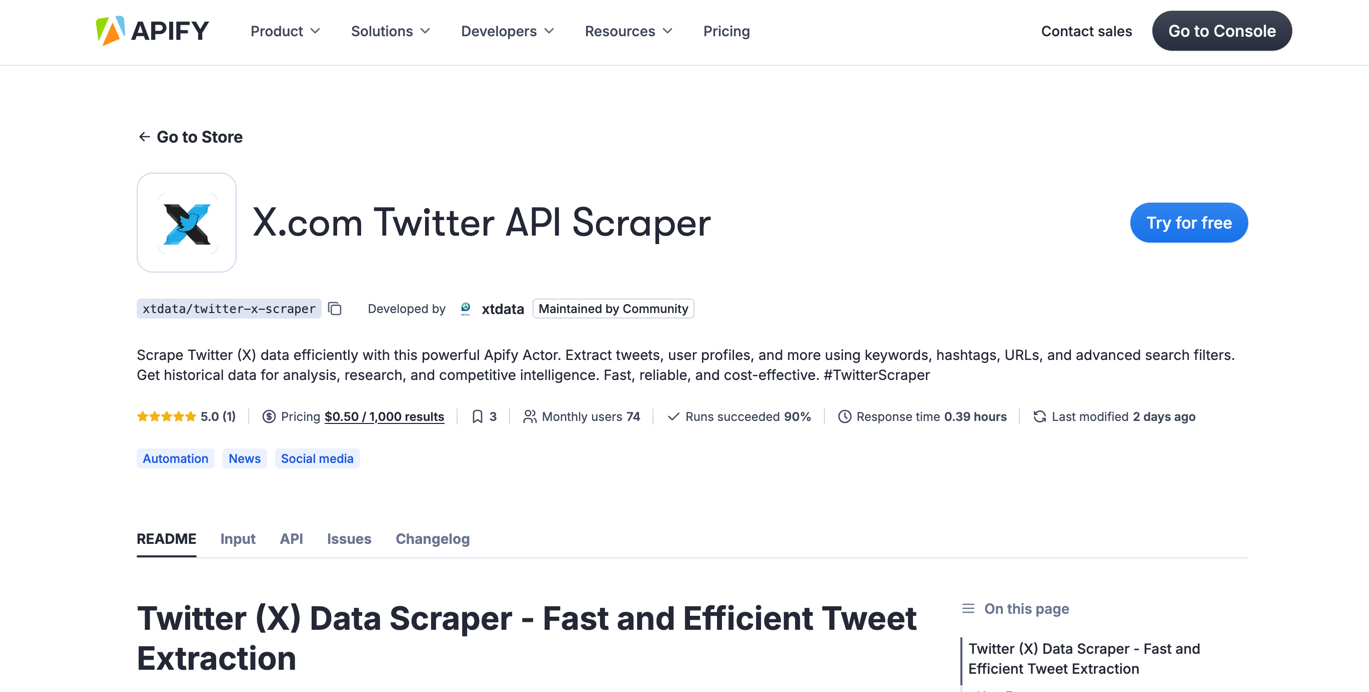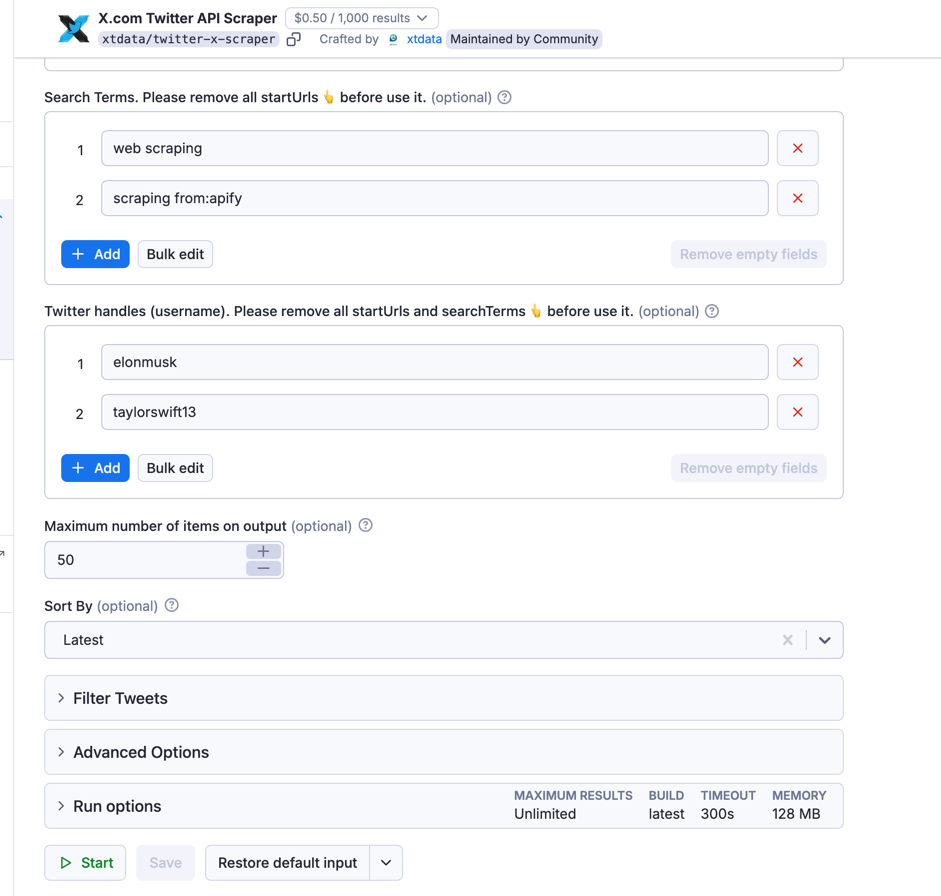Scraping X.com (Twitter) in 2025 Without Writing Code
We often find ourselves needing to access and analyze vast amounts of data. In the digital age, social media platforms like X.com (formerly Twitter) are treasure troves of information for various purposes, from market research to brand monitoring. But what if you need this data without diving into the complexities of coding? This guide will walk you through how to scrape X.com data in 2025 without writing a single line of code using Apify’s X.com Twitter API Scraper.
Why Scrape X.com Data?
The data available on X.com can be invaluable for numerous business and analytical use cases. Here are a few key examples:
- Brand Monitoring: Keep track of mentions of your brand, identify potential copyright violations, detect fraud, and address misinformation that could harm your reputation. By monitoring relevant keywords and hashtags, you can proactively manage your online presence.
- Financial Insights: Understand emerging trends, market fluctuations, and the impact of political climates by analyzing conversations and sentiment on X.com. This data can inform investment decisions and identify potential opportunities.
- Consumer Research: Gain direct insights into the voice of the customer and conduct social listening studies. Social media data provides a constantly updating source for understanding consumer opinions and preferences.
Introducing Apify’s X.com Twitter API Scraper
Apify offers a platform with various pre-built web scraping tools called “Actors”. One such powerful Actor is the * *X.com Twitter API Scraper. This tool is designed for **efficiently extracting historical data from X.com without requiring any coding knowledge. It allows you to gather tweets, user profiles, and more using various criteria.
Key features of the Apify X.com Twitter API Scraper include:
- Multiple Input Methods: Use keywords, hashtags, URLs, and advanced search operators to specify the data you need. You can also extract tweets from specific user handles.
- Powerful Filtering: Refine your results by setting limits on the number of tweets, sorting by “Top” or “Latest,” filtering by language, targeting verified users or Twitter Blue subscribers, and extracting only tweets with specific media types (images, videos, quotes). You can also specify a date range.
- Advanced Options: Include the search terms in your output and utilize the Query Wizard for creating complex queries.
- Fast Performance: The scraper is designed for speed, efficiently extracting data.
- Cost-Effective: Apify offers competitive pricing for their Actors.
Important Note: This scraper is designed for fetching historical data, not for real-time monitoring.
Step-by-Step Guide to Scraping X.com with Apify’s Tweet X.com Scraper
Based on the tutorial provided by Novi Develop, here’s how you can use Apify’s Tweet X.com Scraper:
1. Prerequisites:
- Apify Account: You’ll need an Apify account. Sign up for free at apify.com.
- Apify API Token: Obtain your API token from the Apify Console under “Integrations.”
- Basic Understanding of Twitter Advanced Search: Familiarity with Twitter’s advanced search operators will greatly enhance your ability to target specific data. You can find more information in Twitter’s Advanced Search Guide.
2. Find the Tweet X.com Scraper on Apify:
- Log in to your Apify account.
- Go to the Apify Store (usually in the navigation menu).
- Search for “X.com Twitter API Scraper”, locate an actor from xtData as the image bellow.
-
Click on the Actor to open its details page (you can also directly access it via https://apify.com/xtdata/twitter-x-scraper).

3. Configure the Input:
The Tweet X.com Scraper offers various input options. Here are the key settings:
- Search Terms: This is the core of your query. You can enter:
- Keywords: Simple words or phrases (e.g.,
artificial intelligence,climate change). - Twitter Handles: Usernames (e.g.,
@elonmusk,@NASA). - Advanced Search Operators: Combine keywords, handles, date ranges, and more using Twitter’s advanced search
syntax. This is highly recommended for precise targeting (e.g.,
from:NASA Mars since:2024-01-01). - Start URLs: Directly provide URLs for tweets or user profiles.
- Conversation IDs: Focus on tweets within a specific conversation (
e.g.,
conversation_id:tweet_id_here keyword_here).
- Keywords: Simple words or phrases (e.g.,
- Max Tweets: Set a limit on the number of tweets to retrieve. This is important for managing costs and preventing excessive run times.
- Sort: Choose between “Top” (most relevant) and “Latest” (chronological order).
- Language: Filter tweets by language using ISO 639-1 codes (e.g.,
enfor English,esfor Spanish). - Filters: Further refine your results:
- Only Verified Users: Target tweets from verified accounts.
- Only Twitter Blue: Target tweets from Twitter Blue subscribers.
- Only Images/Videos/Quotes: Limit results to tweets containing specific media types.
Example Input Configurations:
- Fetching Tweets Mentioning “Apify” and “#webscraping”:
{ "searchTerms": [ "Apify #webscraping since: until:" ], "maxTweets": 100, "sort": "Latest", "tweetLanguage": "en" } - Fetching Tweets from a Specific User (@OpenAI) Containing Images:
{ "searchTerms": [ "from:OpenAI" ], "maxTweets": 50, "sort": "Top", "onlyImage": true } - Fetching Tweets from a Specific Profile (e.g., NASA) over Multiple Time Periods:
{ "includeSearchTerms": false, "onlyImage": false, "onlyQuote": false, "onlyTwitterBlue": false, "onlyVerifiedUsers": false, "onlyVideo": false, "searchTerms": [ "from:elonmusk AI since:2023-01-01 until:2023-03-01", "from:elonmusk AI since:2023-03-01 until:2023-05-01", "from:elonmusk AI since:2023-05-01 until:2023-07-01", "from:elonmusk AI since:2023-07-01 until:2023-09-01", "from:elonmusk AI since:2023-09-01 until:2023-12-01" ], "sort": "Latest", "tweetLanguage": "en" } - Fetching Replies to a Specific Tweet with a Hashtag:
{ "includeSearchTerms": false, "onlyImage": false, "onlyQuote": false, "onlyTwitterBlue": false, "onlyVerifiedUsers": false, "onlyVideo": false, "searchTerms": [ "conversation_id:tweet_id_here #hashtag_here" ], "sort": "Latest", "tweetLanguage": "en" }
4. Run the Scraper:
- After configuring the input, click the “Start” or “Run” button.
- Monitor the scraper’s progress on the Apify platform.
-
The run time will depend on your query complexity and the number of tweets requested.

5. Download Your Data:
- Once the scraper finishes, you’ll see the results.
- Download the data in various formats such as JSON, CSV, Excel, or HTML, choosing the format that best suits your needs.
- Click the download button to retrieve your data.
Important Usage Guidelines
Keep these guidelines in mind when using the Apify X.com Twitter API Scraper:
- Historical Data Only: This tool is for retrieving historical data, not for real-time monitoring.
- Concurrency Limits: Be aware of limits on concurrent runs. Check the Actor’s documentation for details.
- Minimum Tweets Per Query: Aim for at least 50 tweets per query (handle, keyword, etc.).
- Single Tweet Fetching Restrictions: Fetching a single tweet by URL is generally prohibited without explicit permission. Allow a few minutes interval time minimum between runs.
- Respect X.com’s Terms of Service: Always use this tool ethically and responsibly.
Conclusion
The ability to access and analyze social media data without needing to code opens up a world of possibilities. Apify’s X.com Twitter API Scraper provides a powerful, flexible, and cost-effective solution for extracting valuable insights from X.com. By following this guide, you can now confidently scrape the data you need for your research, analysis, and business intelligence endeavors. Start exploring the potential of X.com data today!
If you want to get specific data from TikTok
You can use the scrapers below. Each scraper is made to help you get different kinds of TikTok data, like hashtags, search results, profiles, or everything at once. You can look at them to see which one you need.